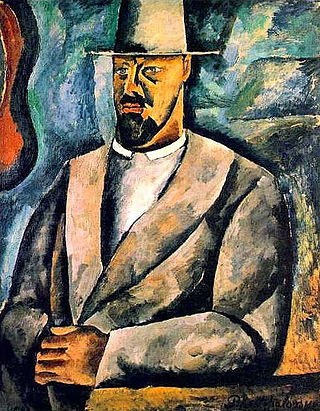Top Qs
Timeline
Chat
Perspective
Pyotr Konchalovsky
Russian painter (1876–1956) From Wikipedia, the free encyclopedia
Remove ads
Pyotr or Petr Petrovich Konchalovsky (Russian: Пётр Петрович Кончаловский; 21 February 1876 – 2 February 1956) was a Russian and Soviet painter. He was a founding member and Chairman of the Knave of Diamonds group.
Remove ads
Biography
Summarize
Perspective
Early life
Pyotr Konchalovsky was born in the village of Slavianka, Izyumsky Uyezd, Kharkov Governorate, Russian Empire, on 21 February 1876. His father was a translator and art publisher, with connections to many artists active in Russia during the late 19th century.[1]
In 1889, the Konchalovskys moved to Moscow and their house became a part of the Moscow art scene of the 1890s. Their house was often visited by Valentin Serov, Konstantin Korovin, Mikhail Vrubel, Vasily Surikov, and Konchalovsky used to spend every weekend at Tretyakov gallery to study the canvases painted by key Russian artists.[2]
During his gymnasium years Konchalovsky attended classes of Moscow School of Painting, Sculpture and Architecture. After advice of Konstantin Korovin and Valentin Serov, in 1896-1898 he traveled to Paris to study at the Académie Julian, one of his classmates being Albert Gleizes. In 1899, he returned to Russia and entered the Imperial Academy of Arts in Saint Petersburg, graduating in 1907. At the academy, he studied under Savinsky, Zaleman and Kovalevsky.[3]
Career
Breakout days in the Moskow avant-guard

In the book “Pyotr Konchalovsky” (1936) by V.Nikolsky Konchalovsky recollects that he “found his art” when he visited Paris for the second time in 1907, and discovered Paul Cezanne and Vincent van Gogh. He even made a week-long trip to Arles, to “penetrate even deeper into van Gogh’s world and to learn his art to the bottom”.[4]
Working under these influences, he made a public debut at the Salon des Indépendants exhibition in Paris, 1908, but Konchalovsky soon returned to Moscow, bringing with him new ideas (elements of his work from this period have been identified as "Fauvist" and cezannism).[5]
By 1909, he was exhibiting frequently, participating in the Golden Fleece, Fraternity, Mir Iskusstva, and New Society of Artists. He was a founding member of the society Knave of Diamonds in 1910, a rebellious, avant-guard group seeking to synthesize the modern art breakthroughs of French and German styles with Russian primitivism. Where Western European looked to African sculptures for artistic refreshment and inspiration, these Russian painters imagined they could turn to "indigenous" Russian works such as icons, provincial tavern and shop signs and street ads, “lubok”-style colorful book illustrations. Konchalovsky was elected as the group's first chairman in 1910.[6]
Post WWI advancements
After serving in the Russian army 1914–1916, Konchalovsky returned to his art with moderated intentions. Beginning in 1918 he taught art. In 1922, he had his first solo exhibition at the Tretyakov Gallery.
During that period, he mostly drew still lifes and landscapes. His paintings—as of all other Jacks of Diamond—remained strongly influenced by Paul Cézanne. But he started to paint portraits (often ceremonial portraits) that are considered examples of socialist realism style.[7]
Personal life
Pyotr married Olga, the daughter of painter Vasily Surikov, who always praised the art of his son-in-law.
Remove ads
Work
Konchalovsky was a very prolific painter, and is known to have created more than five thousand works over the course of his long creative life. His work demonstrates a "complex evolution" of styles.[8]
The influence of Paul Cezanne was "clearly visible" in Konchalovsky's paintings in the pre-WWI period. [9]
Heralded as a member of Russia's avante guard, post war he became a Member of the U.S.S.R. Academy of Fine Arts and a People's Artist of the R.S.F.S.R.[10]
His paintings are considered to have made a significant contribution to "the development of Soviet realistic art."[11]
Remove ads
Legacy
Many of his descendants remained active in the world of art. His son Mikhail Petrovich Konchalovsky (1906-2000) was a noteworthy painter. His daughter Natalia Konchalovskaya (1903–1988) was a significant children's writer and her husband Sergey Mikhalkov a notable poet, the author of children's poetry and two versions of the State Anthem of the Soviet Union and the present National anthem of Russia. They have two sons: Andrei Konchalovsky, a film writer, director and a painter (whose son Egor is also a notable film director) and Nikita Mikhalkov, also a movie director who, in 1994, won the Best Foreign Language Film Oscar for his film Burnt by the Sun.[12]
In 2006, his heirs established the Petr Konchalovsky Foundation, a non-commercial beneficial organization created to consolidate Konchalovsky's legacy. In addition to organizing exhibitions and presentations of Konchalovsky's artworks, the foundation is dedicated to conservation and authentication of the artist's work.[13]
A street in Moscow is named after the artist.[14]
Galleries
- Pyotr Konchalovsky paintings, pre-WWI
- Natasha Konchalovskaya on a chair (1910) Pyotr Konchalovsky
- Matador Manuel Gartha (1910)
- Bullfight (1910)
- Bridge (1911)
- Cassis, the view from the window (1913)
- House in Abramtsevo (1911)
- Agave (1916)
- Pyotr Konchalovsky paintings, Soviet period
- Tree against the sky (1923)
- Portrait of Vsevolod Meyerhold (1938)
- Self-portrait (1943) Soviet Stamp from 1976
- Winter Landscape, birch trees (1947)
- Rose (1955) Soviet Stamp from 1979
Remove ads
References and sources
Bibliography
External links
Wikiwand - on
Seamless Wikipedia browsing. On steroids.
Remove ads













